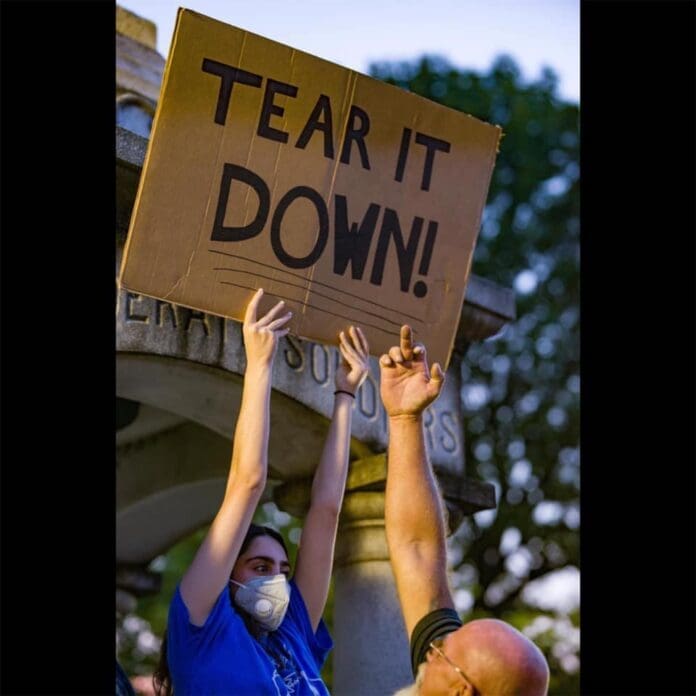By Dave Thompson/For the Sentinel
Driving up to the Court Square the evening of July 15, 2020, my nerves were already frayed.
Less than two months earlier, in Paducah, I’d seen a small cloud of protestors blossom into a supercell that marched miles with a level of intensity that rocked my nice-white-liberal understanding of race relations.
A subsequent protest in Grand Rivers had featured tense exchanges with bystanders, and in Benton the presence of an armed group of onlookers rattled not only protestors but seasoned journalists.
But Murray felt different.
Whether it was the very physical icon of slavery and segregation drawing energy like a lightning rod, or the well-coordinated efforts of Sherman Neal and other protestors not to let the moment fizzle and die, Murray felt more focused.
Unlike many other communities where all the righteous anger brought about not much more than nebulous “dialogues,” Murray had a tangible goal that struck right at the heart of the identity politics of the pro-confederate south: Take down a monument of Robert E. Lee. Across the country, specific, focused efforts to remove confederate flags or monuments seemed to attract more outrage than your average nonviolent march for racial equality.
Murray was no exception. We all got an education in 2020.
Living all my teen years and most of my 20’s in Virginia, pro-confederate perspectives were nothing new. In Appomattox County, the Richmond-based Museum of the Confederacy had opened a state-of-the-art satellite location that I reported on for the local newspaper. I’d visited the primary location in Richmond, transfixed by artifacts and original documents that would make any history lover’s head spin.
I never bought into the “lost cause” mythology myself, and while I always would have cast the longest side-eye at anyone who claimed the war’s primary cause wasn’t slavery, I kept (for the most part) civil relations with many people I “agreed to disagree” with on the causes of the war. Most people I ever interacted with regarding any discussion of the war maintained some veneer of the academic.
Certainly, the rebel flag lived on shirts, bumper stickers, historic displays and celebrations of rural southern culture. I always knew there were more intense, angry supporters of the Confederacy. I wasn’t living in Virginia in 2017, when a young woman named Heather Heyer was killed while counter-protesting at a white supremacist rally opposing the idea of removing another Robert E. Lee statue.
I’d never in person seen a concentrated pro-Confederate group together, fighting with their backs against the wall until July 15, and Charlottesville’s tragedy loomed large in my mind as I approached the courthouse.
The protestors must have arrived first, because by the time I rolled up, the evening the Calloway County Fiscal Court had voted against efforts to remove the monument, they had staked out the space directly underneath Lee’s likeness. It wasn’t long after I arrived that I snapped a photo that will live in my memory forever. A young woman protestor, masked as a precaution against COVID-19, displaying a sign reading “tear it down,” staring down a decades-older bearded man making an obscene gesture toward her or her sign.
The woman I would shortly learn was Linda Arakelyan, a student at Murray State University, while I wouldn’t learn the man’s name until later, and I never interacted with him. Arakelyan told me in an interview that, while she felt threatened by some of the counter-protestors, she found protesting to be empowering and eye-opening. Good for her, because at that time, I wouldn’t have stood in her shoes for anything. The confrontation, while not physically violent, was far from civil.
Protestors against Lee’s statue brought up comparisons with Germany where Nazi icons are not allowed to be displayed. Counter-protestors tossed out an occasional n-word, some tried to “reason” that Black people are more prone to criminal behavior, and while the pro-statue crowd sometimes criticized protestors for swearing, some in their own number threw out phrases like “ni**er loving son of a wh*re” with no opposition from within their group.
That evening is seared into my memory. I reported on multiple other protests in Murray, but the continued pressure never materialized in change. Lee, who owned slaves and fought for a movement dedicated to continuing and protecting the right to traffic humans, still stands tall at the site where the government placed a privileged space for white residents as similar segregated spaces proliferated across America and cities sought to legally keep Black citizens as second-class residents.
There was no physical violence in Murray on July 15, but it was far from “peaceful.”
It’s so telling that the first question many will ask about any racial justice protest is “was it peaceful?” Yes, some protests were beset by violence and property damage, but it seems so disingenuous to make “peace” a prerequisite to deem a protest legitimate or acceptable.
Is it not rational to expect anger, strong language, forceful demands when confronting a continued cultural violence that’s beset our country for centuries? A violence that first touched our shores when ships carried slaves to the “new world” among the earliest European settlers.
In violence, half of our country refused to give up the dehumanizing enterprise of slavery until half a million Americans died in a brutal war, and even then refused to accept the basic humanity or Black people and fought hard against giving them basic human rights.
In violence, the post-confederate South drove Black residents out of “sundown towns” like Benton, Ky., destroyed prosperous Black communities like in Tulsa, Okla., brought literal coups against majority-Black elected governments like in Wilmington, N.C. Decades of lynching and legal segregation continued that pattern of violence, meeting the nonviolent resistance of Martin Luther King, Jr. with force and then targeting people of color for prison (and by extension free labor) under the veneer of “criminal justice reform.”
We continue that violence to this day in blatantly racist gerrymandering laws and opposition to protecting voting rights, meeting any attempt to remedy these centuries of oppression with scorn and opposition while claiming racism somehow magically disappeared some time between the Civil War and now.
And above it all stand the shadows of Robert E. Lee, Jefferson Davis, Stonewall Jackson, Nathan Bedford Forrest, along with scores of politicians who fought against human rights memorialized in statues and busts and holidays and the names of streets and schools across America.
No, no one got injured on July 15. But the defense of Lee’s likeness represents the heart of the violence that America still inflicts on its Black population.
I can’t conclude without touching on another irony of massive proportions. Defenders of the statues are quick to claim that the statues represent “history,” and that removing these monuments lovingly commemorating the fight for slavery is somehow akin to “erasing history.” “Learn from history or repeat it,” they say. And yet, this group refuses even to acknowledge the roots of its own history. Who is doing the erasing?
Take Nikki Haley. Last month, Haley, a presidential candidate, somehow couldn’t find the word “slavery” in her answer to a question regarding the cause of the Civil War.
It’s ironic because Haley previously served as governor of South Carolina, the first state to secede in 1860, which explicitly tied its secession to slavery, particularly the “increasing hostility” of the non-slaveholding states and their refusal to enforce fugitive slave acts.
Whether through genuine ignorance as a victim of the “lost cause” mythology that has sought since the war to frame the slaveholding states as principled defenders of “states’ rights” for whom slavery wasn’t a primary issue, or through a political cynicism capitalizing on pro-confederate conservative votes by refusing to offend their delicate sympathies, Haley demonstrated just how much history has been erased by these staunch defenders of memorials to human traffickers.
But the erasure is deeper than that.
Because even Lee and Jackson and Forrest stand on the shoulders of Thomas Jefferson, George Washington and James Madison, our glorious “founding fathers” who wrote or affirmed that “all men are created equal” while refusing to practice or guarantee human rights and expanding the country’s territory while slaughtering millions of its earlier inhabitants.
America loves to erase. Anything that puts our heroes or our policies or our history in the slightest negative light gets whitewashed or erased or reframed to the point where we can’t be trusted. If we can’t tell the whole truth about the genocide of the indigenous people, about the significance of the slave trade to the building of our country, about the cause of the Civil War, the violence of Jim Crow and the carceral state, how can we be trusted to tell the truth about anything?
It’s time to stop the violence, stop erasing our bloody, brutal history and stop celebrating and defending the people who fought to keep in place one of the worst systems of oppression in world history.
Dave Thompson is a former journalist and photographer who reported for outlets in Virginia, Kentucky and Massachusetts. He has also worked in advocacy and educational media. He visits New England beaches as often as possible, listens to too much Taylor Swift, loves classic literature and history podcasts.
Photo by Dave Thompson for the Paducah Sun.




